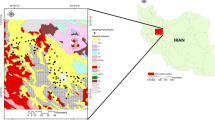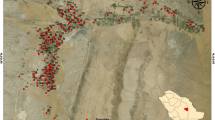Abstract
Saudi Arabia (SA) lies in an arid region where groundwater is the main natural resource; therefore, it is essential to understand the groundwater dynamics for the best groundwater management practice in SA. In Hadat Ash-Sham Farm Experimental Station, SA, water table data from 11 wells and rainfall data were monitored for 16 months. The water table (WT) data is analyzed using the geostatistical method with the ordinary Kriging technique to generate the best WT spatial distribution map for each month and the expected flow direction. The cross-validation technique is used to evaluate the goodness of the developed WT maps. The Kriging maps show two regimes: weak spatial dependence (WSD, the ratio of the nugget to sill > 75%) and strong spatial dependence (SSD, the ratio of the nugget to sill < 25%). The WSD regime happens during dry seasons, while the SSD happens during wet seasons. The SSD gives better results and accuracy when compared to WSD. The root-mean-square error (RMSE) of WT varies between 0.26 and 3.4 m in the case of SSD, while it varies between 0.51 and 4.8 m in the case of WSD. WT maps show that the groundwater flow direction is from south-east to north-west during the wet season (SSD). This direction is in the orientation of surface stream with higher elevation (in the south) to the surface stream with lower elevation (in the north), where the study area is between these surface streams. While during the dry season (WSD), there is no preferred direction since there is almost no flow.











Similar content being viewed by others
Data availability statement
We will make all data available upon request.
References
Ahmadi SH, Sedghamiz A (2007) Geostatistical analysis of spatial and temporal variations of groundwater level. Environ Monit Assess 127:277–294. https://doi.org/10.1007/s10661-006-9361-z
Ahmed S, Devi K (2008) Kriging for estimating hydrogeological parameters. In: Ahmed S, Jayakumar R, Salih A (eds) Groundwater dynamics in hard rock aquifers. Springer, Dordrecht. https://doi.org/10.1007/978-1-4020-6540-8_13
Al-Omran AM, Al-Wabel MI, El-Maghraby SE, Nadeem ME, Al-Sharani S (2013) Spatial variability for some properties of the wastewater irrigated soils. J Saudi Soc Agric Sci 12(2):167–175. https://doi.org/10.1016/j.jssas.2012.12.001
Cambardella CA, Moorman TB, Novak JF, Parkin TB, Karlen DL, Turco RF, Konopka AE (1994) Field-scale variability of soil properties in Central Iowa soils. Soil Sci Soc Am J 58(5):1501–1510. https://doi.org/10.2136/sssaj1994.03615995005800050033x
Chai T, Draxler RR (2014) Root mean square error (RMSE) or mean absolute error (MAE)? Arguments against avoiding RMSE in the literature. Geosci Model Dev 7:1247–1250. https://doi.org/10.5194/gmd-7-1247-2014
Delhomme JP (1978) Kriging in the hydrosciences. Adv Water Resour 1(5):251–266. https://doi.org/10.1016/0309-1708(78)90039-8
El-Hames AS (2005) Determination of groundwater availability in shallow arid region aquifers utilizing GIS technology: a case study in Hada Al-Sham, Western Saudi Arabia. Hydrogeol J 13:640–648. https://doi.org/10.1007/s10040-004-0323-7
ESRI (2020) Understanding a semivariogram: the range, sill, and nugget. Retrieved 18 Dec 2020, from ArcGIS Pro help: https://pro.arcgis.com/en/pro-app/latest/help/analysis/geostatistical-analyst/semivariogram-and-covariance-functions.htm
Fitts CR (2012) Groundwater science. Academic Press, London
Hohn ME (1999) The semivariogram. In: Geostatistics and petroleum geology, pp 15–80. Springer, Dordrecht. https://doi.org/10.1007/978-94-011-4425-4_2
Johnston K, Ver Hoef J, Krivoruchko K, Lucas N (2003) Using ArcGIS geostatistical analyst. Retrieved from ArcGIS 9: http://help.arcgis.com/en/arcgisdesktop/10.0/pdf/geostatistical-analyst-tutorial.pdf
Kis IM (2016) Comparison of ordinary and universal Kriging interpolation techniques on a depth variable (a case of linear spatial trend), case study of the Sandrovac field. Min Geol Pet Eng Bull. https://doi.org/10.17794/rgn.2016.2.4
Kumar S, Sondhi SK, Phogat V (2005) Network design for groundwater level monitoring in upper Bari Doab canal tract. Irrig Drain 54(4):431–442. https://doi.org/10.1002/ird.194
Kuswantoro M, Al-Amri NS, Elfeki AM (2014) Geostatistical analysis using GIS for mapping groundwater quality: case study in the recharge area of Wadi Usfan, western Saudi Arabia. Arab J Geosci. https://doi.org/10.1007/s12517-013-1156-2
Lloyd CD (2010) Model for spatial analysis, 2nd edn. Boca Raton, CRC Press
McLean MI, Evers L, Bowman AW, Bonte M, Jones WR (2018) Statistical modelling of groundwater contamination monitoring data: a comparison of spatial and spatiotemporal methods. Sci Total Environ 652:1339–1346. https://doi.org/10.1016/j.scitotenv.2018.10.231
Mehrjardi RT, Jahromi MZ, Mahmodi S, Heidari A (2008) Spatial distribution of groundwater quality with geostatistics (case study: Yazd-Ardakan Plan). World Appl Sci J 4(1):9–17
Okello C, Tomasello B, Greggio N, Wambiji N, Antonellini M (2015) Impact of population growth and climate change on the freshwater resources of Lamu Island, Kenya. Water 7:1264–1290. https://doi.org/10.3390/w7031264
Oliver MA, Webster R (2015) Basic steps in geostatistics: the variogram and Kriging. Springer, Berlin. https://doi.org/10.1007/978-3-319-15865-5
Rouhani S (1989) Geostatistics in water resources. In: Proceedings of the 1989 Georgia water reosources conference. The University of Georgia, Georgia
Rouhani S, Hall TJ (1989) Space-time Kriging of groundwater data. In: Amstrong M (ed) In quantitative geology and geostatistics, vol 4, 4th edn. Springer, Dordrecht, pp 639–650. https://doi.org/10.1007/978-94-015-6844-9_50
Rubin A (2012) Statistics for evidence-based practice and evaluation, 3rd edn. University of Texas at Austin, Austin
Wackernagel H (1995) Ordinary Kriging. Springer, Berlin, Heidelberg. https://doi.org/10.1007/978-3-662-03098-1_11
World Bank Group (2019) World Bank open data. Retrieved 05 Mar 2020, from https://data.worldbank.org/indicator/AG.LND.PRCP.MM
Acknowledgements
The authors would like to express gratitude to the technical staff of the Department of Hydrology and Water Resources Management, Faculty of Meteorology, Environment, and Arid Land Agriculture, King Abdulaziz University, who measured and collected the data at Hadat Ash-Sham Farm Experimental Station in 16 months.
Funding
Not available.
Author information
Authors and Affiliations
Corresponding author
Ethics declarations
Conflict of interest
Authors declare that no conflict of interest could be perceived as prejudicing the impartiality of the research reported.
Additional information
Publisher's Note
Springer Nature remains neutral with regard to jurisdictional claims in published maps and institutional affiliations.
Rights and permissions
About this article
Cite this article
Budiman, J.S., Al-Amri, N.S., Chaabani, A. et al. Geostatistical based framework for spatial modeling of groundwater level during dry and wet seasons in an arid region: a case study at Hadat Ash-Sham experimental station, Saudi Arabia. Stoch Environ Res Risk Assess 36, 2085–2099 (2022). https://doi.org/10.1007/s00477-021-01971-9
Accepted:
Published:
Issue Date:
DOI: https://doi.org/10.1007/s00477-021-01971-9




